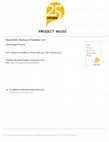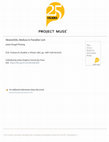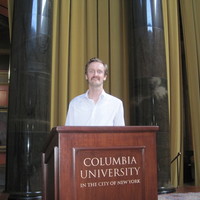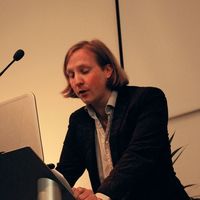Papers by James Dougal Fleming
The seventeenth-century shorthand movement
Routledge eBooks, Apr 11, 2024
Metascience, Jun 12, 2017
There was such a thing as the scientific revolution, and this is the book about it. For David Woo... more There was such a thing as the scientific revolution, and this is the book about it. For David Wootton, modern natural science is a function of discovery. Early modern Europe discovered discovery and thereby invented science. Wootton presents this argument as a commonsense counterblast against modish relativism. By that token, he recognizes that his historical argument is epistemologically entangled. But he seems to think that the argument itself unties the knot. The paralogism of this approach is reflected in Wootton's account of the discovery question. In this review essay, I'll provide a detailed account of Wootton's discussion, followed by a critique. In my conclusion, I'll suggest an alternative way of thinking about the invention of discovery in early modern Europe.
Cahiers François Viète, Oct 1, 2019
qu'il interprète en fonction des nouvelles circumnavigations des XV e et XVI e siècles. L'Écritur... more qu'il interprète en fonction des nouvelles circumnavigations des XV e et XVI e siècles. L'Écriture laisse prévoir une croissance des savoirs à la fin des temps ; c'est à cette espérance apocalyptique que Bacon rattache sa philosophie naturelle. Il attaque l'Aristotélisme de la Renaissance pour proposer une science qui serait complètement nouvelle, mais qui-les spécialistes l'ont démontré-reste très près de l'ancienne. La solution à cette énigme passe par l'exégèse baconienne de Daniel : la fin du monde sert de méta-théorie à la science de Bacon.

In 2016, information was becoming intelligence-fi nally. Humanoid robots, able to answer question... more In 2016, information was becoming intelligence-fi nally. Humanoid robots, able to answer questions and recognize facial expressions, were an increasingly common achievement of advanced tech labs. Virtual reality, a "fi rst steps" technology since the 1990s, was seriously bidding to transform gaming, cinema, and who knew what else. Self-driving cars were on the roads of California; they were only test models (by Google and others), and were experiencing some interesting problems, but the technology was still widely expected to come to market very soon. IBM's Watson, scion of the program that had soundly defeated "Jeopardy!" champions in 2011, was being marketed to businesses and professionals as a new kind of "cognitive assistant": able to (per their advertising) take data in all its forms, understand it, learn from it and reason through it. The fi lm Ex Machina-2001 for the millennial generation-caught the moment, depicting a reclusive robotics genius and his sentient, even sensitive, creation. To many people, it seemed only a matter of time before we reached the technological tipping-point that had long been popularized by the futurist Ray Kurzweil: when powerful analytic engines, interacting online, would suddenly become collectively self-aware and transcendently smart. The virtual brain would then either make us immortal through its bits; or reduce us to our own. The infosphere, in short, seemed to be approaching The Singularity. 1 A signifi cant step along the way had to do with translation of natural language. This was a leading edge of the broader technology of natural language processing-no longer a graveyard of Artifi cial Intelligence (AI) ambition. Google and Microsoft had already for several years offered free and instant online translation between and among dozens of languages. At the same time, a number of companies, including Systran, WordLingo, and Wordbee, were offering fee-based translation softwares (presumably more powerful than the free products). Facebook, which used to offer translation, now just went ahead and did it automatically, unless you turned that feature off. (You could still turn it off.) Twitter, less boisterously, made you click an icon to obtain a tweet translation-and then asked if you wanted to improve it. And indeed, the results of online translation, the free versions, anyway, were still pretty iffy; sometimes very iffy. But couldn't you get some kind of a gist even from a very imperfect translation? And wasn't this better than no translation at all? It was of course assumed that this particular capability of the infosphere was still only on its fi rst steps. Eventually, maybe even before the rise of the machines, we could hope for its fulfi llment. Information itself-the universal machine language-would then make all discourse instantly available to any local understanding. The curse of Babel would be undone; universal machine translation would, effectively, make all languages one. Thrilling promise? Or ridiculous hype? You know better than I. If you're reading these words, they're dated; maybe very dated. As we discussed in the Introduction, nobody can keep up, for more than a moment, with the expansion of the infosphere. That is the whole reason for trying to seek the shapes of information in its past, rather than its future. In this fi nal chapter, I want to ask to what extent the real character, as envisioned in Wilkins's Essay , can offer us a critical perspective on the project of universal translation. This is a capability that the real character is supposed to support-for which, indeed, it is in part designed. In effect, the character is supposed to be able to function as a universal translation hub, turning freely at the center of the linguistic system precisely because it is not a "language" itself. This is the same kind of function, when it comes to the possibility of universal machine translation, that is claimed for the ons and offs of informational code, or Mathematical Theory of Communication Information (MTCI). I argued in the last chapter that Wilkins's real character is, to an interesting extent, phenomenologically (though not technically) congruent to the latter. In this fi nal chapter, I'm going to argue that the universalizing promise of the character, as an information technology, involves some unpalatable trade-offs at the level of ontology. The Essay towards a Real Character offers to take us to a new world. But not neces
The Undiscoverable Country: Occult Qualities, Scholasticism, and the End of Nescience
Routledge eBooks, Mar 3, 2016
Afterword: The Art of the Field

Milton Quarterly, Mar 1, 2002
Although stylistic and other considerations identify Milton's Nativity Ode as an early compositio... more Although stylistic and other considerations identify Milton's Nativity Ode as an early composition, its specific and traditional dating to Christmas 1629 depends on a single piece of evidence. This is the poem's headnote, "Compos'd 1629," in the 1645 Poems of Mr John Milton (Fletcher 1:157). In Milton's 1673 Poems the Nativity Ode goes undated (Fletcher 1:15), while the 1645 headnote is confirmed (as far as I am aware) by no other Miltonic or early-critical text. Not even the Elegia Sexta indicates in which Christmastide Milton is writing his Nativity poem (Fletcher 1:114-16, 213-33); though a 1629 date for the Elegia is almost as traditional as that for the Ode, the date appears to derive from the Latin poem's association with the English one. In short, an entire complex of Miltonic dating leads back to that headnote in the 1645 Moseley volume. The headnote in the Moseley volume, moreover, may not constitute a fact. Other chronological headings in Civil War and Interregnum poetry collections, like that over "Lycidas" in the 1645 Poems (Fletcher 1:185), appear to tell us more than when the poet wrote the poem. It seems reasonable to suspect, and several critics have, that "Compos'd 1629" may be similarly hermeneutic. But if it is, as I will argue here, it is probably not reliable as an authorial statement of timeline. For the year 1629, attached to a poem on Christ's Nativity, published in the winter of 1645-46, is a politically reactionary and-one would therefore think-unMiltonic interpretant. The initial context for this interpretant is the Parliamentarian banning of Christmas. The ban had been unofficially in force since 1643, when the House stopped observing the feast, and officially since promulgation of the Westminster Assembly's Directory of Public Worship in January 1645 (new style, a year before Milton's Poems). The festival, however, would not go quietly into the midwinter night. Godly merchants who tried to ignore Christmas Day, by opening for business against festive tradition, had their shops stoned and shut, and their persons threatened with death, by reactionary crowds (Durston, "Lords"; Perfect). The imprecise, on the other hand, continued to hold and seek services and festivities, though facing a Parliamentary response including arrest, imprisonment, and fines. In 1646 and '47 Christmas riots would break out in Bury St. Edmunds and Ipswich respectively, while Canterbury would spend the 1647 season in open revolt, a Christmas Commune (Declaration, Canterbury). Christopher Durston has characterized the failure of Interregnum radical governance as the failure of a Puritan Cultural Revolution. To the Red Guards of reformation, Christmas was a critical and a recalcitrant sign of the old society. Their attempts to efface the sign, 20 MILTON QUARTERLY in a predictable semiotic paradox, reinscribed it with oppositional values of nostalgia and resistance (Durston, "Lords"; Hutton 206-17), while creating a pamphlet war around the subject that raged throughout the Interregnum (Bernard; Chindley; Fisher; Warmstry; Woodward; Taylor; Vindication). In all these controversies, pro-Christmas positions are anti-reform positions, and pro-reform positions are anti-Christmas positions. When the royalist balladeer wished to evoke and lament a world turned upside down, he did so neatly and succinctly by singing "Christmas was killed at Naseby fight" ("World" 43). Laureate Caroline poets like to sing this song, too. We should, perhaps, identify them as laureate post-Caroline poets: as Warren Chernaik has observed, much lyric written in or about the 1630s comes to us only through the single-author publications of the 1640s and '50s. Chernaik perceives a posthumousness to Laudio-Caroline poetry that should be crossed, I think, with the political analysis offered by James Loxley. The "drawn sword" of literary royalism, in Loxley's dramatic phrase, is always possibly out in the mid-seventeenth-century collections. But the battle, as per Chernaik, has been lost when the collections appear; so that post-Caroline poetry-as though by definition-offers a curious and characteristic fusion of belatedness and defiance. Crashaw, Herrick, Cartwright, Lluelyn, Suckling, Howell, Vaughan, Cleveland and others all mix those clashing colors on the template of Christmas poetry. Few of the post-Caroline collections offer no Christmastide pieces, while most offer several, or even complex and rewarding series (Herrick; Cartwright; Felltham; Forde). A useful contrast can be drawn here with the creative predilections of earlier Stuart poets. Donne and Herbert, for example, write few Christmas pieces, and the pieces they do write tend to be meditative, and non-calendrical. But the Christmas feasts as feasts, as the calendrically-guaranteed high holy days of seventeenth-century England, are a prominent feature of the post-Caroline publications. I say "feasts as feasts" because in the seventeenth century there are three: Christmas Day, New Year's or Circumcision Day, and Epiphany or Twelfth Night (Chambers). The "New-Year's Gift" is particularly popular among the post-Carolines, but Epiphany and Christmas Day itself are also much written on. All three days, moreover, count very much as Christmas days. The post-Caroline Yuletide tendency is not, I think, hard to understand. In discontinuing festival days, "vulgarly called holy days," the Directory of Public Worship asserted that such observances had "no warrant from the word of God" (Westminster 85). Post-Caroline Christmas poetry answers, effectively, "this is the month, and this the happy morn." By its very existence, the Yuletide poem is a cultural and political memorial, offering an implicit complaint to the radical regime. Implicit, to be sure, often becomes explicit. The hardcore Laudian Martin Lluelyn, in his Carol for 1644, observes that Christ's "Altars sinke," under radical assault, and urges Charles to "assist his rescue then/ Gainst Sacreligious men" (43, 51-52). Henry Vaughan, in his "Christ's Nativity," exclaims "Alas, my God!… thy birth now here/ Must not be numbered in the year" (36, 47-8). And James Howell, in his "New-Year's Gift" of 1642, prays that Charles may "go on to vindicate the right/ Of holy things, and make the Temple bright" (225-26). But even when the political content of the Yuletide text is held more in reserve, the text itself is often published under suggestive post-Caroline backdating. Suckling's Moseley collection, for example, begins with a poem "On New-years day 1640. To the KING." The piece is bravely titled-but Suckling is dead, the king's cause is

ELH, 2002
Medusa is a character in Paradise Lost. I use the word "character" advisedly: the Gorgon has been... more Medusa is a character in Paradise Lost. I use the word "character" advisedly: the Gorgon has been studied for her role in the poem's symbolism, but not (as far as I know) for her moment in its action. The moment is a confound to that model of the poem in which meaning is arranged above the level of the story, in the narrator's design of a dense symbolic discourse. For Medusa is not controlled by such a discourse; but presents instead the problem of a semiotic radical, hazardously placed within story itself. 1 The episode in question occurs in book 2, Hell. Satan has just left Pandemonium for the world. Milton is describing the "advent'rous" fallen angels, and gesturing towards "the damn'd" of an indeterminate future. 2 After three of Hell's rivers, and the continent of ice, Milton brings his subjects to the river of Lethe. There, they struggle to reach the water in order to lose "with one small drop" "all pain and woe" (2.608-9). They are "so near the brink": But Fate withstands, and to oppose th'attempt Medusa with Gorgonian terror guards The Ford, and of itself the water flies All taste of living wight, as once it fled The lip of Tantalus.

Through a Glass, Literally: From Shorthand to Wilkins’s Essay
Here Fleming explains how Wilkins’s Essay, the masterwork of the real-character movement, grew di... more Here Fleming explains how Wilkins’s Essay, the masterwork of the real-character movement, grew directly out of the earlier shorthand-character movement. He tells the story of George Dalgarno, the obscure Scottish schoolmaster whose innovations in shorthand provided the basis for Wilkins’s work—turning “literal” characters, referring to words, into “real” or “universal” ones, referring (it was felt) directly to things. Fleming explains and examines the widespread seventeenth-century assumption that minds reflect the world directly, and that minds the world over reflect it in the same way. This simple epistemology, which Fleming calls the speculative view, provides the basis for the idea of real characters. Signs that referred to the notions of the mind would by that token refer directly to things, avoiding the confusions and distortions of language. A character, moreover, does not count as a language, in early-modern terms—and not in modern or postmodern ones, either.

Unreal Characters: Technology and Orality in the Seventeenth Century
In this chapter, Fleming returns to the historical basis for his investigation. With an eye on gi... more In this chapter, Fleming returns to the historical basis for his investigation. With an eye on giving an account of John Wilkins’s great Essay towards a real character (1668), Fleming first of all tells the story of unreal characters: methods of shorthand, which were invented in England in the late sixteenth century, and took the next one by storm. Fleming gives an unusually extensive survey of what remains a neglected historical field. He also finds occasion for phenomenological reflection in the technology of shorthand, as it confronts and challenges seventeenth-century oral discourse. The very category of language, Fleming suggests, may owe something to this period synthesis. The chapter ends with a discussion of the seventeenth-century craze for “Theophrastan” character sketches, which, Fleming argues via Ben Jonson, may in the first place have been a reaction against the previous emergence of shorthand.

Introduction: The Mirror of Information in Early Modern England
In his introduction, Fleming establishes the real or universal character movement of seventeenth-... more In his introduction, Fleming establishes the real or universal character movement of seventeenth-century England as the main target of his historical investigation. He also outlines the hypothesis of a phenomenological comparison between period technologies of the real character—an objective code allowing scientific discourse about items in an encyclopedic database—and modern information theory. With reference to Hubert Dreyfus’s failed 2001 attempt to show that internet search would never work (falsified, almost immediately, by the rise of Google), Fleming argues that real-time critiques of the infosphere are doomed to failure. He then proposes that a historical perspective may be more promising. Dreyfus’s earlier 1972 critique, articulating the “first step” fallacy of artificial intelligence research, is a guide. We may be able to learn something about the nature of information, as both theory and technology, by looking into the early-modern real-character movement: the mirror of information.
Labors of Innocence in Early-Modern England - By Joanna Picciotto
Milton Quarterly, Mar 1, 2012
Introduction: The Invention of Discovery, 1500–1700

Making Sense of Science and the Literal: Modern Semantics and Early Modern Hermeneutics
Palgrave Macmillan UK eBooks, 2007
Peter Harrison has argued that modern natural science was able to begin once biblical allegory go... more Peter Harrison has argued that modern natural science was able to begin once biblical allegory got out of the way. The withdrawal of scripture from natural philosophy was, allegedly, the result of exegetic literalism.1 This argument, while intriguing, accords with a positivist epistemology in which science is the knowledge that begins where reading and interpretation (or hermeneutics) end. Reified in the process is an idea of literal interpretation as strict, uncreative, and true to its (textual) objects — in a word, as scientific. At the same time, the hermeneutic validity of the literal is proved, as it were, by a narrative of its spontaneous emergence in history, before the science that it reflects. This essay will argue, against Harrison’s account, that literalism cannot be understood as science’s post-hermeneutic precondition. For literalism requires very considerable hermeneutic construction; and emergent science, in particular Copernicanism, actively and influentially engaged in this construction. Science may or may not be a historical epiphenomenon of literalism, but literalism is certainly a hermeneutic entailment of science.

Through a Glass, Literally: From Shorthand to Wilkins’s Essay
The Mirror of Information in Early Modern England, 2016
Here Fleming explains how Wilkins’s Essay, the masterwork of the real-character movement, grew di... more Here Fleming explains how Wilkins’s Essay, the masterwork of the real-character movement, grew directly out of the earlier shorthand-character movement. He tells the story of George Dalgarno, the obscure Scottish schoolmaster whose innovations in shorthand provided the basis for Wilkins’s work—turning “literal” characters, referring to words, into “real” or “universal” ones, referring (it was felt) directly to things. Fleming explains and examines the widespread seventeenth-century assumption that minds reflect the world directly, and that minds the world over reflect it in the same way. This simple epistemology, which Fleming calls the speculative view, provides the basis for the idea of real characters. Signs that referred to the notions of the mind would by that token refer directly to things, avoiding the confusions and distortions of language. A character, moreover, does not count as a language, in early-modern terms—and not in modern or postmodern ones, either.

ELH, 2002
Medusa is a character in Paradise Lost. I use the word "character" advisedly: the Gorgon has been... more Medusa is a character in Paradise Lost. I use the word "character" advisedly: the Gorgon has been studied for her role in the poem's symbolism, but not (as far as I know) for her moment in its action. The moment is a confound to that model of the poem in which meaning is arranged above the level of the story, in the narrator's design of a dense symbolic discourse. For Medusa is not controlled by such a discourse; but presents instead the problem of a semiotic radical, hazardously placed within story itself. 1 The episode in question occurs in book 2, Hell. Satan has just left Pandemonium for the world. Milton is describing the "advent'rous" fallen angels, and gesturing towards "the damn'd" of an indeterminate future. 2 After three of Hell's rivers, and the continent of ice, Milton brings his subjects to the river of Lethe. There, they struggle to reach the water in order to lose "with one small drop" "all pain and woe" (2.608-9). They are "so near the brink": But Fate withstands, and to oppose th'attempt Medusa with Gorgonian terror guards The Ford, and of itself the water flies All taste of living wight, as once it fled The lip of Tantalus.
part of the material is concerned, specifi cally the rights of translation, reprinting, reuse of ... more part of the material is concerned, specifi cally the rights of translation, reprinting, reuse of illustrations, recitation, broadcasting, reproduction on microfi lms or in any other physical way, and transmission or information storage and retrieval, electronic adaptation, computer software, or by similar or dissimilar methodology now known or hereafter developed. The use of general descriptive names, registered names, trademarks, service marks, etc. in this publication does not imply, even in the absence of a specifi c statement, that such names are exempt from the relevant protective laws and regulations and therefore free for general use.











Uploads
Papers by James Dougal Fleming